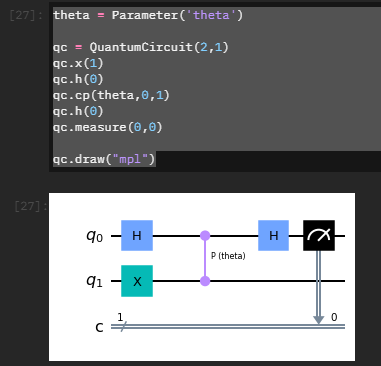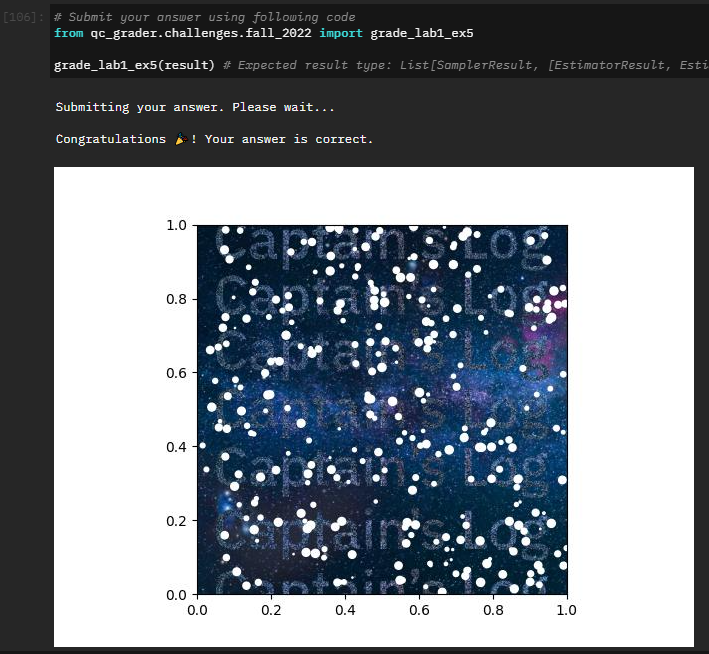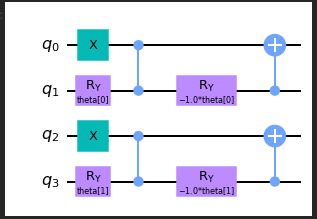はじめに
2022/11/11 ~ 11/18 の期間に開催された IBM Quantum Challenge Fall 2022 のメモ兼参加記録です。
内容としては以下のとおり。
- Lab1: Qiskit Runtime、Sampler、Estimator入門
- Lab2: Sampler、Estimatorの練習問題。量子サポートベクターマシンQSVMのお気持ち
- Lab3: 組み合わせ最適化問題である巡回セールスマン問題のQUBO変換
- Lab4: 量子化学計算VQE
lab1
Exercise 1
文字列 string が与えられたときのベルンシュタイン・ヴァジラニ回路の関数を作る。
def bernstein_vazirani(string): # Save the length of string string_length = len(string) # Make a quantum circuit qc = QuantumCircuit(string_length+1, string_length) # Initialize each input qubit to apply a Hadamard gate and output qubit to |-> for i in range(string_length): qc.h(i) qc.x(string_length) qc.h(string_length) qc.barrier() # Apply an oracle for the given string # Note: In Qiskit, numbers are assigned to the bits in a string from right to left rev_string = string[::-1] for i in range(string_length): if rev_string[i] == "1": qc.cx(i, string_length) qc.barrier() # Apply Hadamard gates after querying the oracle for i in range(string_length): qc.h(i) # Measurement qc.measure(range(string_length), range(string_length)) return qc
実行結果は以下のような感じ。

Exercise 2
回路qcは以下の形で与えられている。

パラメータ theta に与える個々の位相 individual_phases も以下の形で与えられている。
phases = np.linspace(0, 2*np.pi, 50) # Specify the range of parameters to look within 0 to 2pi with 50 different phases # Phases need to be expressed as list of lists in order to work individual_phases = [[ph] for ph in phases]
Sampler を使い、パラメータ化された回路にパラメータをバインドする。以下が答え。
with Session(service=service, backend=backend): sampler = Sampler(options=options) job = sampler.run(circuits=[qc for _ in range(50)], parameter_values=individual_phases) result = job.result()
上記のコードは、theta でパラメータ化された回路に、individual_phases の各パラメータをバインドしている。その50個分の回路の結果を実行し、集約された結果が得られるというわけらしい。
Exercise 3
【ステップ1】 RealAmplitudes を使ってランダムな回路を作る。
# Make three random circuits using RealAmplitudes n_qubit = 5 reps1 = 2 reps2 = 3 reps3 = 4 psi1 = RealAmplitudes(n_qubit, reps=reps1) psi2 = RealAmplitudes(n_qubit, reps=reps2) psi3 = RealAmplitudes(n_qubit, reps=reps3)
【ステップ2】 SparsePauliOp を使ってハミルトニアンを作る。
- SparsePauliOpの使い方
# Make hamiltonians using SparsePauliOp H1 = SparsePauliOp.from_list([("IIZXI",1), ("YIIIY",3)]) H2 = SparsePauliOp.from_list([("IXIII",2)]) H3 = SparsePauliOp.from_list([("IIYII",3), ("IXIZI",5)])
【ステップ3】 numpy.linspace を使って theta の値を等間隔に作る。
# Make a list of evenly spaced values for theta between 0 and 1 theta1 = np.linspace(0, 1, n_qubit*(reps1+1)) theta2 = np.linspace(0, 1, n_qubit*(reps2+1)) theta3 = np.linspace(0, 1, n_qubit*(reps3+1))
【ステップ4】 Estimator を使って各期待値を計算する。
- Estimatorの使い方
# Use the Estimator to calculate each expectation value with Session(service=service, backend=backend): options = Options(simulator={"seed_simulator": 42},resilience_level=0) # Do not change values in simulator estimator = Estimator(options=options) # calculate [ <psi1(theta1)|H1|psi1(theta1)>, # <psi2(theta2)|H2|psi2(theta2)>, # <psi3(theta3)|H3|psi3(theta3)> ] # Note: Please keep the order qcs = [psi1, psi2, psi3] pvs = [theta1, theta2, theta3] obs = [H1, H2, H3] job = estimator.run(circuits=qcs, parameter_values=pvs, observables=obs) result = job.result()
print(result) # EstimatorResult(values=array([ 0.003 , 1.749 , -1.0685]), metadata=[{'variance': 9.999775, 'shots': 4000}, {'variance': 0.9409989999999997, 'shots': 4000}, {'variance': 33.04502775, 'shots': 4000}])
Exercise 4
- 完全な誤り訂正符号の実装はオーバーヘッドがでかい。
- このオーバーヘッドは現状、現実的ではない。
- 現時点では、小さなオーバーヘッドの実装で、エラー軽減することを目指している。
- これらの技術はエラー緩和、エラー抑制と呼ばれている(関連するIBMの記事)。
Qiskit Runtimeには、よく使うエラー緩和とエラー抑制機能が組み込まれている。
- DynamicalDecoupling
Samplerでは、resilience_level=1にするとM3が有効になる。Estimatorでは、resilience_level=1にするとT-REX、resilience_level=2にするとデジタルZNEが有効になる。ほかにもエラー緩和策を選べる。
以下は、トリビア問題の回答。ほとんどテキストに書いてある。私の理解に沿った理由を記載するが、誤っている可能性があるので参考程度に。
- 誤り訂正は誤り軽減と同じである。
- 誤り。完全な誤り訂正の代替案として、エラー緩和やエラー抑制といった誤り軽減を利用している。
- DDのためにX-gateを適用する場合、2回だけ適用することが可能である。
- 誤り。X-gateを2回適用するとなにもしないのと同じになるので、DDのためにこれをすることはある。が、2の倍数ならOKだろう。
- DDには最適なデカップリング順序が重要である。
- 正しい。ハードウェアの都合上、パルスの長さは有限であり、完全な回転を実現できないので、適切なDDシーケンスを使用する必要がある。
- M3 は量子測定誤差緩和のためのものである。
- M3を使用する場合,Resilience levelを2に設定する必要がある。
- 誤り。
Samplerでは、resilience_level=1にするとM3が有効になる。
- 誤り。
- T-REXはコヒーレントな誤差を確率的な誤差に変化させる。
- 正しい。「パウリ・トワリング」と呼ばれる手法でコヒーレントな誤差を確率的な誤差に変換している。
- ZNEは誤り訂正技術であり、耐故障性QCに使用される。
- 誤り。誤り軽減技術である。
- ZNEはノイズのスケールファクターを増幅し、ノイズがないときの測定値を推定する。
- 正しい。「ゼロノイズ外装(Digital Zero-noise Extrapolation, ZNE) を利用し、異なるノイズファクターに対する測定の期待値を計算し(増幅ステージ)、次に測定した期待値を使ってゼロノイズ限界での理想的な期待値を推測します(外挿ステージ)。この方法は期待値の誤差を減らす傾向がありますが、バイアスのない結果が得られることは保証されていません。(テキストの原文ママ)」
- グローバル・フォールディングは、量子パルスを物理的に引き伸ばすアナログ的な方法である。
- 誤り。ローカル・フォールディングと同じ操作を回路全体に適用する、デジタル的な手法である。
- ZNEを用いると、すべての誤差を軽減することができる。
- 誤り。期待値の誤差を減らす傾向はあるが、バイアスのない結果が得られるとは限らない。
Exercise 5
Sampler の回路は以下。
# build your code here sampler_circuit = bernstein_vazirani("11111") sampler_circuit.draw()
Estimator の回路は以下。
estimator_circuit = QuantumCircuit(2) estimator_circuit.h(0) estimator_circuit.cx(0,1) estimator_circuit.ry(Parameter("theta"), 0) estimator_circuit.draw()
各パラメータ、観測値は以下。
# parameters for estimator_circuit number_of_phases = 10 phases = np.linspace(0, 2*np.pi, number_of_phases) individual_phases = [[ph] for ph in phases] # observables for estimator_circuit Z0Z1 = SparsePauliOp.from_list([("ZZ",1)]) X0Z1 = SparsePauliOp.from_list([("ZX",1)]) Z0X1 = SparsePauliOp.from_list([("XZ",1)]) X0X1 = SparsePauliOp.from_list([("XX",1)]) ops = [Z0Z1, X0Z1, Z0X1, X0X1] # DO NOT CHANGE THE ORDER
Options の設定は以下。
# Import FakeBackend fake_backend = FakeManila() noise_model = NoiseModel.from_backend(fake_backend) options_with_em = Options( simulator={ # Do not change values in simulator "noise_model": noise_model, "seed_simulator": 42, }, # build your code here. Activate TREX for Estimator and M3 for sampler. resilience_level=1 )
以上の設定で、Sampler と Estimator を実行する。
with Session(service=service, backend=backend): sampler = Sampler(options=options_with_em) sampler_result = sampler.run(circuits=sampler_circuit).result() estimator = Estimator(options=options_with_em) estimator_result = [] for op in ops: job = estimator.run(circuits=[estimator_circuit]*number_of_phases, parameter_values=individual_phases, observables=[op]*number_of_phases) result = job.result() estimator_result.append(result)

Exercise 6
message = "Captain's Log"
クリアすると限定公開の動画が見れる。今回、SFのストーリーがあり、しかも結構面白い。
Lab2
Exercise 1
from qiskit.circuit.library import RealAmplitudes def lab2_ex1(): qc = RealAmplitudes(num_qubits=4, reps=1, entanglement=[[0,1], [2,3], [1,2]], insert_barriers=True) return qc qc = lab2_ex1() qc.decompose().draw('mpl')
Exercise 2
M3について正誤問題。Lab1の4.1章を復習する。
Matrix-free Measurement Mitigation (M3) に関する以下の記述について、正しいか否かを答えてください。
Q1:M3は量子ゲートエラー緩和技術であり、フォールト・トレラントな量子コンピューターに使用される。
- 誤り。量子ゲートではなく、量子測定の誤差軽減技術である。
Q2:M3は、指数関数的なオーバーヘッドをランダムビット列の数によるスケーリングに落とし込んで作られる部分空間において動作する。
- 誤り。ランダムビット列ではなく、ノイズの多い入力ビット列によってスケーリングする。
Q3: M3は、ノイズのスケールファクターを増幅し、ノイズがない場合の測定値を推定する。
- 誤り。ゼロノイズ外挿(ZNE)の説明。
Q4: M3の技術は、直接的な解決方法と比較して、緩和のためのメモリー使用量を削減することができる。
- 正しい。行列を圧縮するので、メモリ使用量を削減できる。一般化最小残差法などを使った行列なしの方法もあるらしい。
Exercise 3
Sampler の文法がわかってきた。統計で例えると、回路のパラメータの個数が標本サイズで、sampler.run() で反復回数(標本数)だけ繰り返し実行するイメージ。
# 標本数 = n theta_list = [[標本1], [標本2], ..., [標本n]] sampler.run(circuits=[qc]*(標本数), parameter_values=theta_list, shots=shots)
で、以下が答え。
# create sampler using simulator and sample fidelities with Session(service=service, backend=backend): sampler = Sampler(options=options) job = sampler.run(circuits=[fidelity_circuit]*len(theta_list), parameter_values=theta_list, shots=shots) fidelity_samples_sim = job.result() sampler = Sampler(options=options_noise) job = sampler.run(circuits=[fidelity_circuit]*len(theta_list), parameter_values=theta_list, shots=shots) fidelity_samples_noise = job.result() sampler = Sampler(options=options_with_em) job = sampler.run(circuits=[fidelity_circuit]*len(theta_list), parameter_values=theta_list, shots=shots) fidelity_samples_with_em = job.result() fidelities_sim = [] fidelities_noise = [] fidelities_with_em = [] for i in range(10): fidelities_sim += [fidelity_samples_sim.quasi_dists[i][0]] fidelities_noise += [fidelity_samples_noise.quasi_dists[i][0]] fidelities_with_em += [fidelity_samples_with_em.quasi_dists[i][0]]
Exercise 4
ここ難しかった。
sample_train を使えと言われている。作成したいカーネル行列は対称な正方行列であるので……。
with Session(service=service, backend=backend): circuits = [fidelity_circuit]*circuit_num pvs = data_append(n, sample_train, sample_train) # sampler = Sampler(options=options_with_em) job = sampler.run(circuits=circuits, parameter_values=pvs, shots=shots) quantum_kernel_em = job.result() #
Exercise 5
今回のカーネル行列は対称行列でないので、すべての要素を計算する必要がある。
たとえば行列の行をsample_train、列を未知のビット列に割り当てるとすると、行列の要素数は以下の通り。
n1 = len(unknown_data) # the number of unknown bit-string n2 = 25 # the number of trained data circuit_num_ex5 = n1*n2 print(circuit_num_ex5)
def data_append_ex5(n1, n2, x1, x2): para_data_ex5 = [] for i in range(n1): for j in range(n2): para_data_ex5.append(list(x1[i]) + list(x2[j])) return para_data_ex5
unknown_data と sample_train で計算されたカーネル行列:kernel_ex5 を計算するための Sampler のコードは以下の通り。
with Session(service=service, backend=backend):
circuits_ex5 = [fidelity_circuit]*circuit_num_ex5
pvs_ex5 = data_append_ex5(n1, n2, unknown_data, sample_train)
sampler = Sampler(options=options_with_em)
job = sampler.run(circuits=circuits_ex5, parameter_values=pvs_ex5, shots=shots)
quantum_kernel_ex5 = job.result()
Lab3
Exercise 1
qubit の数は、イジングモデルをイメージする。
# Let us first generate a graph with 4 nodes! #### enter your code below #### n = 4 num_qubits = n**2 #### enter your code above #### tsp = Tsp.create_random_instance(n, seed=123) adj_matrix = nx.to_numpy_matrix(tsp.graph) print("distance\n", adj_matrix) colors = ["r" for node in tsp.graph.nodes] pos = [tsp.graph.nodes[node]["pos"] for node in tsp.graph.nodes] draw_graph(tsp.graph, colors, pos)
Exercise2
与えられた二次問題をQUBOに変換し、イジングハミルトニアンを求めよという問題。
from qiskit_optimization.converters import QuadraticProgramToQubo #### enter your code below #### qp2qubo = QuadraticProgramToQubo() #instatiate qp to qubo class qubo = qp2qubo.convert(qp) # convert quadratic program to qubo qubitOp, offset = qubo.to_ising() #convert qubo to ising #### enter your code above #### print("Offset:", offset) print("Ising Hamiltonian:", str(qubitOp))
Exercise 3
Matsuo, A., Suzuki, Y., & Yamashita, S. (2020). Problem-specific parameterized quantum circuits of the VQE algorithm for optimization problems. arXiv preprint arXiv:2006.05643.の論文の3.2.1節を参考にして、3量子ビットのW状態を構築せよという問題。
from qiskit import QuantumRegister, ClassicalRegister from qiskit.circuit import ParameterVector, QuantumCircuit # Initialize circuit qr = QuantumRegister(3) cr = ClassicalRegister(3) circuit = QuantumCircuit(qr,cr) # Initialize Parameter with θ theta = ParameterVector('θ', 2) #### enter your code below #### # Apply gates to circuit circuit.x(0) circuit.ry(theta[0], 1) circuit.cz(0,1) circuit.ry(-theta[0], 1) circuit.ry(theta[1], 2) circuit.cz(1,2) circuit.ry(-theta[1], 2) circuit.cx(1,0) circuit.cx(2,1) #### enter your code above #### circuit.measure(qr,cr) circuit.draw("mpl")
Exercise 4
from qiskit_ibm_runtime import Session, Sampler, Options options = Options(simulator={"seed_simulator": 42},resilience_level=0) #DO NOT CHANGE #### Enter your code below #### # Define sampler object with Session(service=service, backend=backend): pvs = [[(54.73/360)*(2*np.pi), (45/360)*(2*np.pi)]] sampler = Sampler(options=options) # Define sampler with options above result = sampler.run(circuits=[circuit], parameter_values=pvs, shots=5000).result() # Run the sampler. Remember, the theta here is in degrees! :) # Plot result result_dict = result.quasi_dists[0] # Obtain the quasi distribution. Note: Expected result type: QuasiDistribution dict #### Enter your code above #### values = list(result_dict.keys()) # Obtain all the values in a list probabilities = list(result_dict.values()) # Obtain all the probabilities in a list plt.bar(values,probabilities,tick_label=values) plt.show() print(result_dict)
Exercise 5
N量子ビットのTSPエンタングラー・ルーチンを構築する関数を作成せよという問題。こういうの見るたび競プロやってて良かったと思う。


from qiskit import QuantumRegister, ClassicalRegister from qiskit.circuit import ParameterVector, QuantumCircuit def tsp_entangler(N): # Define QuantumCircuit and ParameterVector size circuit = QuantumCircuit(N**2) theta = ParameterVector('theta',length=(N-1)*N) ############# # Hint: One of the approaches that you can go for is having an outer `for` loop for each node and 2 inner loops for each block. / # Continue on by applying the same routine as we did above for each node with inner `for` loops for / # the ry-cz-ry routine and cx gates. Selecting which indices to apply for the routine will be the / # key thing to solve here. The indices will depend on which parameter index you are checking for and the current node! / # Reference solution has one outer loop for nodes and one inner loop each for rz-cz-ry and cx gates respectively. ############# #### enter your code below #### theta_i = 0 for i in range(N): # X Gate circuit.x(i*N) # Parameter Gates for j in range(i*N+1, i*N+N): circuit.ry(theta[theta_i], j) circuit.cz(j-1, j) circuit.ry(-theta[theta_i], j) theta_i += 1 # CX gates for j in range(i*N+1, i*N+N): circuit.cx(j, j-1) #### enter your code above #### return circuit
Exercise 6
- VQE
- qiskit.algorithms.minimum_eigensolvers.MinimumEigensolver.compute_minimum_eigenvalue VQEはQuantum Primitive用にリファクタリングされたらしく、検索しても古い方法しか出てこない。テキストを読んでお気持ちエスパーしながら実装する。
引数:
- estimator: ハミルトニアン演算子の期待値を計算するためのestimator primitive。
- ansatz: 試行状態のためのパラメーター化された量子回路。
- optimizer: 最小エネルギーを求めるための古典的なオプティマイザー。Qiskit.Optimizer、または.Minimizerプロトコルを実装したcallableとすることができる。
- initial_point: オプティマイザーの初期点(つまり、パラメーターの初期値)。初期点の長さは、ansatzのパラメーターの数と一致しなければならない。Noneの場合、特定のパラメーター範囲内でランダムな点が生成されます。SamplingVQEは、この範囲をansatzから求めます。ansatzが範囲を指定していない場合、-2\pi, 2\piの範囲が使用されます。
- callback: 各最適化ステップで中間データにアクセスできるコールバック。これらのデータは、評価回数、ansatzのオプティマイザーのパラメーター、estimatorの値、およびメタデーターの辞書です。
まず、3ノードのTSPエンタングラーを作成しておく。
# Define PQC for 3 node graph (Hint: Call the previous function you just made) PQC = tsp_entangler(3)
RunVQE 関数は以下の通り。
def RunVQE(estimator, model, optimizer, operator, init=None): # Store intermediate results history = {"eval_count": [], "parameters": [], "mean": [], "metadata": []} # Define callback function def store_intermediate_result(eval_count, parameters, mean, metadata): history["eval_count"].append(eval_count) history["parameters"].append(parameters) history["mean"].append(mean.real) #### Enter your code below #### # Define VQE run vqe = VQE(estimator=estimator, ansatz=model, optimizer=optimizer, initial_point=init, callback=store_intermediate_result) # Compute minimum_eigenvalue result = vqe.compute_minimum_eigenvalue(operator=operator, aux_operators=None) #### Enter your code above #### return result, history["mean"]
VQEを実行し、結果を得るためのコードは以下の通り。Estimator に options を渡さないことに注意。
%%time # Do not change the code below and use the given seeds for successful grading from qiskit.utils import algorithm_globals from qiskit.primitives import Estimator algorithm_globals.random_seed = 123 # Define optimizer optimizer = SPSA(maxiter=50) # Define Initial point np.random.seed(10) init = np.random.rand((n-1)*n) * 2 * np.pi # Define backend backend = service.backends(simulator=True)[0] #### Enter your code below #### # Call RunVQE with Session(service = service, backend = backend): estimator = Estimator() result, mean = RunVQE(estimator=estimator, model=PQC, optimizer=optimizer, operator=qubitOp, init=init) #----# Enter your code here. Do not pass in options) #### Enter your code above #### # Print result print(result)
Exercise 7
前回計算したVQE結果から得られたパラメータを使って、最適化回路に渡す。
テキストに書いてあるが、Estimator に渡す parameter_values 引数は、result.optimal_parameters の値を渡す。
def BestBitstring(result, optimal_circuit): energy = result.eigenvalue.real options = Options(simulator={"seed_simulator": 42},resilience_level=0) # Do not change and please pass it in the Sampler call for successful grading #### enter your code below #### with Session(service = service, backend = backend): # Enter your code here. Please do pass in options in the Sampler construct. sampler = Sampler(options=options) job = sampler.run(circuits=[optimal_circuit], parameter_values=[list(result.optimal_parameters.values())]) sampler_result = job.result() # Obtain the nearest_probability_distribution for the sampler result from the quasi distribution obtained result_prob_dist = sampler_result.quasi_dists[0].nearest_probability_distribution() #### enter your code above #### max_key = format(max(result_prob_dist, key = result_prob_dist.get),"016b") result_bitstring = np.array(list(map(int, max_key))) return energy, sampler_result, result_prob_dist, result_bitstring
Exercise 8

一般化よくわかんなかったです👽。
n = 3 model_3 = QuantumCircuit(n**2) theta = ParameterVector('theta',length=(n-1)*n//2) # Build a circuit when n is 2 model_3.x(0) model_3.x(6) # Apply a parameterized W state gate model_3.ry(theta[0],1) model_3.cz(0,1) model_3.ry(-theta[0],1) model_3.cx(1,0) model_3.cx(1,3) model_3.cx(0,4) model_3.ry(theta[1],7) model_3.cz(6,7) model_3.ry(-theta[1],7) model_3.ry(theta[2],8) model_3.cz(7,8) model_3.ry(-theta[2],8) model_3.cx(7,6) model_3.cx(8,7) # Apply 4 CSWAP gates model_3.cswap(6,0,2) model_3.cswap(6,5,3) model_3.cswap(7,1,2) model_3.cswap(7,4,5) model_3.draw("mpl")
Exercise 9
4ノードでVQE解を求めよという問題。いままで作った関数を駆使して実装する。
QUBO は以下の通り。
#### Enter your code below #### qp = tsp.to_quadratic_program() qp2qubo = QuadraticProgramToQubo() qubo = qp2qubo.convert(qp) qubitOp_4, _ = qubo.to_ising() #### Enter your code above ####
model は以下の通り。なんかソラから実装させようとしてきたけど、めんどくさいのでしない。
model = tsp_entangler(n)
Lab4
化学わかんね~~~🧪🤷
- VQEに関するQiskit Natureのチュートリアル
- Qiskit Githubの githubリポジトリの最初のページ
- 各機能を使用するためのベースコードを含む testフォルダ
- test_molecule_driver.py
Exercise 1
Å :オングストロームと読む。1Å = 10^{-10} メートル。
value の値は、図の「???」の距離を計算する。正三角形なので計算できるのだが、小数点第6位まできっかりの値じゃないと grade はクリアできない。どういうこと?
Molecule モジュールのページが Not Found なのでエスパーすると、
hydrogen_t = [["原子記号", [x座標, y座標, z座標]], ...]multiplicityは、多重度。今回は1らしい(テキストに書いてある)。chargeは、電荷?たぶん1。
#### Fill in the values below and complete the function to define the Molecule #### # Coordinates are given in Angstrom # value = 0.791513 / 3**(1/2) # 0.4569802436170883 value = 0.456980 hydrogen_t = [["H", [value, 0.0, 0.0]], # ----------- Enter your code here ["H", [-value, 0.0, 0.0]], # ----------- Enter your code here ["H", [0.0, 0.791513, 0.0]]] h3p = Molecule( # Fill up the function below geometry=hydrogen_t, # ----------- Enter your code here multiplicity=1, # ----------- Enter your code here charge=1, # ----------- Enter your code here ) driver = ElectronicStructureMoleculeDriver(h3p, basis="ccpvdz", driver_type=ElectronicStructureDriverType.PYSCF) properties = driver.run()
Exercise 2
次に、Estimator を使ってどのようにルーチンを設定するかを定義します。Estimatorは量子回路から推定される期待値と物理量を返します。ここで渡す回路 は私たちの ansatz で、物理量 は先ほど作成した qubit_op_parity ハミルトニアンで、パラメータ値 はここで x として渡した古典オプティマイザーで処理される値です。この例では、同時摂動確率的近似(SPSA)オプティマイザーを使用しています。(テキスト引用)
optimizer で最小化するスカラー関数は evaluate_expectation 。x0 引数には initial_point を入れる。
サンプルコード内の job_list には、PrimitiveJob ではなく 実際には EstimatorResult が入る。ややこしい。
%%time from qiskit.utils import algorithm_globals algorithm_globals.random_seed = 1024 # Define convergence list convergence = [] # Keep track of jobs (Do-not-modify) job_list = [] # Initialize estimator object estimator = Estimator()# Enter your code here # Define evaluate_expectation function def evaluate_expectation(x): x = list(x) # Define estimator run parameters #### enter your code below #### # job = estimator.run(circuits=[ansatz], observables=[qubit_op_parity], parameter_values=[x]) # PrimitiveJob ではなく、EstimatorResultを入れる job = estimator.run(circuits=[ansatz], observables=[qubit_op_parity], parameter_values=[x]).result() # ----------- Enter your code here results = job.values[0] job_list.append(job) # Pass results back to callback function return np.real(results) # Call back function def callback(x,fx,ax,tx,nx): # Callback function to get a view on internal states and statistics of the optimizer for visualization convergence.append(evaluate_expectation(fx)) np.random.seed(10) # Define initial point. We shall define a random point here based on the number of parameters in our ansatz initial_point = np.random.random(ansatz.num_parameters) #### enter your code below #### # Define optimizer and pass callback function optimizer = SPSA(maxiter=50, callback=callback) # ----------- Enter your code here # Define minimize function result = optimizer.minimize(fun=evaluate_expectation, x0=initial_point) # ----------- Enter your code here
Exercise 3
construct_problem は以下。
def construct_problem(geometry, charge, multiplicity, basis, num_electrons, num_molecular_orbitals): molecule = Molecule(geometry=geometry, charge=charge, multiplicity=multiplicity) driver = ElectronicStructureMoleculeDriver(molecule, basis=basis, driver_type=ElectronicStructureDriverType.PYSCF) # Run the preliminary quantum chemistry calculation properties = driver.run() # Set the active space active_space_trafo = ActiveSpaceTransformer(num_electrons=num_electrons, num_molecular_orbitals=num_molecular_orbitals) # Now you can get the reduced electronic structure problem problem_reduced = ElectronicStructureProblem(driver, transformers=[active_space_trafo]) # ----------- Enter your code here # The second quantized Hamiltonian of the reduce problem second_q_ops_reduced = problem_reduced.second_q_ops() # Set the mapper to qubits parity_mapper = ParityMapper() # This is the example of parity mapping # Set the qubit converter with two qubit reduction to reduce the computational cost parity_converter = QubitConverter(parity_mapper) # ----------- Enter your code here # Compute the Hamitonian in qubit form qubit_op_parity = parity_converter.convert(second_q_ops_reduced.get('ElectronicEnergy'), num_particles=problem_reduced.num_particles) # Get reference solution vqe_factory = VQEUCCFactory(quantum_instance=StatevectorSimulator(),optimizer=SLSQP(),ansatz=UCC(excitations='sd')) solver = GroundStateEigensolver(parity_converter, vqe_factory) real_solution = solver.solve(problem_reduced).total_energies[0] ansatz=vqe_factory.ansatz return ansatz, qubit_op_parity, real_solution, problem_reduced
custom_vqe は以下。
def custom_vqe(estimator, ansatz, ops, problem_reduced, optimizer = None, initial_point=None): # Define convergence list convergence = [] # Keep track of jobs (Do-not-modify) job_list = [] # Define evaluate_expectation function def evaluate_expectation(x): x = list(x) # Define estimator run parameters job = estimator.run(circuits=[ansatz], observables=[ops], parameter_values=[x]).result() # ----------- Enter your code here results = job.values[0] job_list.append(job) # Pass results back to callback function return np.real(results) # Call back function def callback(x,fx,ax,tx,nx): # Callback function to get a view on internal states and statistics of the optimizer for visualization convergence.append(evaluate_expectation(fx)) np.random.seed(10) # Define initial point. We shall define a random point here based on the number of parameters in our ansatz if initial_point is None: initial_point = np.random.random(ansatz.num_parameters) # Define optimizer and pass callback function if optimizer == None: optimizer = SPSA(maxiter=50, callback=callback) # Define minimize function result = optimizer.minimize(fun=evaluate_expectation, x0=initial_point) # ----------- Enter your code here vqe_interpret = [] for i in range(len(convergence)): sol = MinimumEigensolverResult() sol.eigenvalue = convergence[i] sol = problem_reduced.interpret(sol).total_energies[0] vqe_interpret.append(sol) return vqe_interpret, job_list, result
grade_lab4_ex3b は、grade_lab4_ex に修正する。
## Grade and submit your solution from qc_grader.challenges.fall_2022 import grade_lab4_ex3 grade_lab4_ex3(construct_problem, custom_vqe)
Exercise 4
construct_problemで電子構造問題を作成する。custom_vqeで基底状態エネルギーを計算する。- グラフ化する。
という流れ。
反応エネルギーを単位[eV]で求めよという問題。
反応エネルギー = 反応後のエネルギー - 反応前のエネルギー
VQE実行の最終的な収束値を使って計算すれば良い。
K_H2eV = 27.2113845 # Hartree -> eV # calculate reaction energy. before_energy = (Energy_H_m[-1] + Energy_H_c[-1]) after_energy = (Energy_H_t[-1] + Energy_H_a[-1]) react_energy = after_energy - before_energy react_vqe_ev = react_energy * K_H2eV # Fill this cell. Please note the reaction energy should be in eV and not in Hartree units for succesful grading. print("Reaction energy VQE estimator eV", react_vqe_ev ,"\n")
Exercise 5
Variational Quantum Deflation (VQD) ルーチンを用いた第一励起状態遷移エネルギー(nm単位)を求める問題。
%%time # Extracting solved initial point from one shot estimation done previously initial_pt = result.raw_result.optimal_point # List to store all estimated observables uccsd_result = [] #### Enter your code below #### for i in range(7): uccsd_result.append(Estimator().run(circuits=[vqe_factory.ansatz], observables=[qubit_op_parity[i]], parameter_values=[initial_pt]).result()) #### Enter your code above #### energy_c_estimator=uccsd_result[0].values[0]+result.extracted_transformer_energy+result.nuclear_repulsion_energy print('Energy = ', energy_c_estimator)
シクロプロペニリデンの全双極子モーメントを求める問題。
双極子モーメントは、分極のベクトルの和であるらしい。方向(符号)に気をつけて足し合わせたあと、ベクトルのマグニチュードを求めれば良い。
双極子モーメント = 活性化双極子モーメント + トランスフォーマーによって抽出された双極子モーメント - 核双極子モーメント
# Fill your codes here, dipole moment computed by Nuclear dipole moment - Electronic dipole moment # and Electronic dipole moment computed by adding VQE reult and ctiveSpaceTransformer extracted energy part dipxau = uccsd_result[4].values[0] + temp_dipoles[0] - temp_nu_dipoles[0] # ----------- Enter your code here (Use Partial information in element 4 in uccsd_result list) dipyau = uccsd_result[5].values[0] + temp_dipoles[1] - temp_nu_dipoles[1] # ----------- Enter your code here (Use Partial information in element 5 in uccsd_result list) dipzau = uccsd_result[6].values[0] + temp_dipoles[2] - temp_nu_dipoles[2] # ----------- Enter your code here (Use Partial information in element 6 in uccsd_result list) au2debye = 1/0.393430307 # Convert to debye dipxdebye = dipxau.real * au2debye dipydebye = dipyau.real * au2debye dipzdebye = dipzau.real * au2debye dip_tot = (dipxdebye**2 + dipydebye**2 + dipzdebye**2)**(1/2) # Compute the total dipole moment magnitude here from the individual components of the vector computed above. print('Dipole (debye) : ', dip_tot)
Final Ranked Exercise
ノイズのある回路でVQE実行するチャレンジ問題。
HACK TO THE FUTURE 2023 予選(AtCoder Heuristic Contest 016)と期間丸かぶりしてて時間なくてやってません><
おわりに
今回はSFのストーリーがあって、ブラックホールからスイングバイ脱出するという目的のもと、スペースデブリの効率的な排除のために巡回セールスマン問題をQUBOを使って解いたり、燃料を節約するために宇宙空間の化学物質の分子特性をVQEを構築して計算するといった流れになっていた。演出もなかなか力が入っていて、ただ単に問題を解くよりもエンターテイメントって感じで面白かったです。
去年と同様、修了証明書としてのバッジをもらえました。